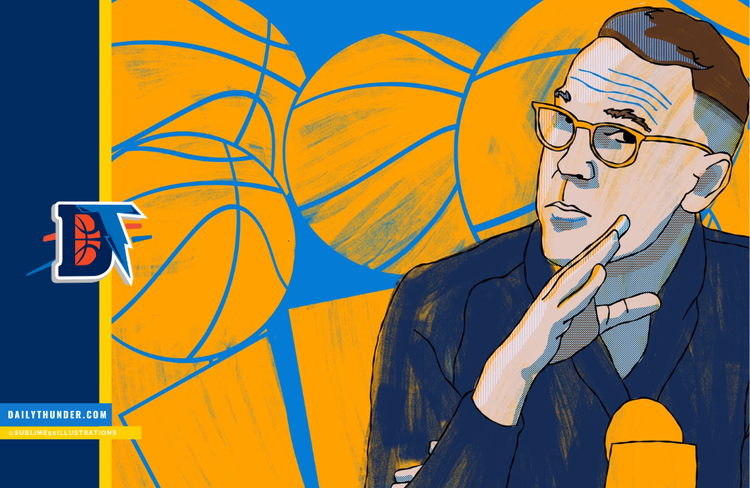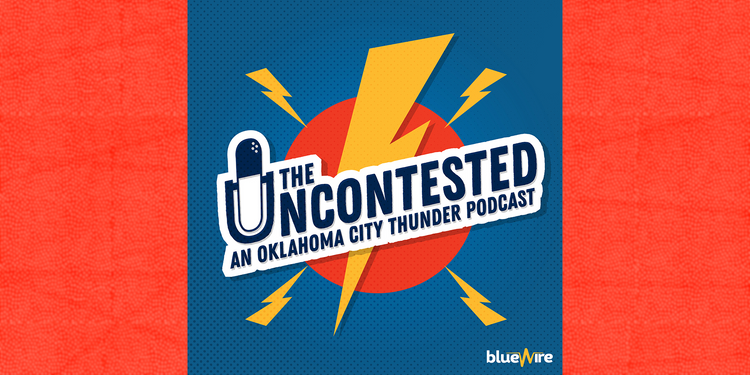A Wing and a Prayer: Evaluating the Thunder’s Trade Deadline Options
It happened in an instant.
Andre Roberson reached out for the lob and his leg just stopped working. Ruptured patellar tendon. Out for the season.
With Roberson’s injury, OKC lost its most impactful non-star wing player, a rangy defender who was already in the Defensive Player of the Year conversation. Single-number metrics have their flaws, but Roberson was 2nd in defensive Real Plus-Minus, a stat that typically favors big men. Though his offense was legitimately bad, his defense was so good that lineups he played in were net positives, even with the negative spacing he provided.
Much has been said already about how much the defense drops off with Roberson off the court. No one can replicate his impact. Wing was Oklahoma City’s weakest position in terms of depth coming into the season, and it’s gotten worse with his injury. Alex Abrines and Terrance Ferguson are not good defenders. Both are known shooters, but the team has generally not been better with them on the floor by the numbers — particularly when they start. Jerami Grant is mostly an unknown on the wing (though limited small forward numbers have been somewhat encouraging), but seems to be entrenched as the second-unit center. Josh Huestis has played limited minutes.
The obvious solution, and perhaps the only one considering the remaining talent, is trade.
Oklahoma City can’t replace Roberson’s defensive impact. Defensive Player of the Year candidates don’t grow on trees. But what they might be able to do is bring back a two-way wing that can provide some of what Roberson lacked, while not opening the door on defense the way Ferguson and Abrines have so far this season.
Below are some of the candidates for two-way wings Oklahoma City should consider.
Alec Burks, Utah Jazz
Alec Burks is an athletic guard who’s struggled with injuries throughout his time in the league, but has been healthy this year. At times he looks like he’s putting it together on the offensive end, while other times he looks like he’s not ready for the spotlight. Listed at 6’6” and 214 pounds, Burks has the size to fit seamlessly into Oklahoma City’s switching scheme.
Burks ranks in the 64th percentile defending the pick-and-roll ball handler and in the 74th percentile defending in isolation, per Synergy — two of the areas he’d be tasked with defending the most. He’s more of a slasher than a shooter, but his spot-up shooting is solid enough to handle the task of spreading the floor if he were to start.
Burks’s injury history is concerning, but his health is the sort of gamble the Thunder may have to take. He makes $10 million this year and $11 million the next, which pinches the Thunder in a heavy tax year, but may be useful as expiring salary—and as a stopgap in the worst-case scenario with Paul George.
…
Garrett Temple, Sacramento Kings
Temple is a journeyman who’s bounced around a little bit through his playing career before landing in Sacramento and finding a home. He’s well-liked there in the locker room, and he’s been a steadying presence on the floor as well. At 6’6”, 195 pounds, he also has the size to defend larger wings and hold his own in switches.
Sacramento uses Temple frequently as a spot-up shooter, and he’s good at it, ranking in the 78th percentile according to Synergy. He’s also a capable playmaker, and the Kings have occasionally used him as a point guard, to reasonable effect. On defense Temple is a capable isolation defender, but struggles guarding pick-and-roll ball handlers. This may be related to the personnel around him, though, and might work itself out in a different environment.
The Kings may want to keep Garrett Temple as a strong veteran voice in the locker room and a solid Swiss Army knife wing who can fill a variety of roles. He’s only making $8 million a year this year with a player option for next (an option he’ll very likely use to stay under contract). But if the Kings decide to move more towards youth, Temple would be an excellent target.
…
Michael Kidd-Gilchrist, Charlotte Hornets
Kidd-Gilchrist, or “MKG”, is a defensive wing in the same mold as Andre Roberson: an excellent defender who can’t shoot a lick. MKG, though, has a few offensive tricks up his sleeve that Roberson doesn’t, while not being quite as effective defensively. He’s 6’7” and 232 pounds, comparable to Dre, and usually has the responsibility of guarding the best wing player on the other team.
The big wing is excellent in transition, but not great at many other areas of offense. He does take advantage of post-ups well, and he’s capable of running a pick-and-roll — his off-the-bounce game is better than Roberson’s. Where Kidd-Gilchrist makes his mark is on defense, where he’s solid across the board. It’s hard to say how his defensive numbers might translate to OKC, which runs a more aggressive defensive scheme against the pick and roll than Charlotte, but he fits Roberson’s mold.
Charlotte is paying a massive bill for a 21-29 team at the time of this writing. With heavy money tied up in Nicolas Batum and Marvin Williams, Charlotte is looking to ease its salary burden. MKG could wind up on the move. At $13 million a year for the next 2 years with a player option, he’s not cheap. But he’s perhaps the most plug-and-play option to fill in for Roberson.
…
Wesley Johnson, Los Angeles Clippers
Johnson’s an interesting case of what happens to players who get drafted too high. Drafted 4th overall in 2010, he’s filled the role of an NBA journeyman. The athleticism has always been there, but Johnson never translated that raw potential into becoming the star player he was thought to be. Instead, he’s become a defensive wing — at 6’7” and 215 pounds, he’s got the build to check the larger guards and forwards that tend to carry the scoring load.
Johnson is an average to bad offensive player, though he can hit the occasional spot-up jumper if left open. His three-point percentage isn’t great, and it’s not a function of contested shots. He’s not great anywhere on the court, barring small sample sizes that don’t indicate much. Almost all of his Synergy defensive numbers are excellent, though. Johnson doesn’t necessarily provide the help defense Roberson does, but as a one-on-one defender he’s useful.
Johnson only makes $6 million this year and has a player option for a similar amount next year, which he’s likely to pick up. With the Clippers in the middle of a rebuild on the fly, he could come available, and the Thunder could use him.
…
Avery Bradley, Los Angeles Clippers
Bradley has a fantastic reputation as a defender, and he’s capable of knocking down open shots when needed. Of the available candidates, his name is one that’s come up perhaps more than any other. However, at 6’2” and 180 pounds, Bradley is one of the smallest shooting guards in the league, and in a switch-heavy defensive scheme like Oklahoma City’s, he might not be nearly as effective as in a one-on-one defensive battle. Though recently traded to the Clippers, he is eligible for trade — a common misconception is that recently traded players can’t be traded for again. They can. They just can’t be aggregated with other players.
Bradley relies heavily on long two-point shots for his offense, which he’s been hitting at a rate below his normal pace this year. He’s a capable shooter from outside, though (in the 82nd percentile for spot-up shots, per Synergy!), and a smart cutter. One-on-one his defense is elite, but the team as a whole generally defends better without him — and this isn’t a new thing. This dates back several years, even on the Boston teams he was so useful for. It’s worth watching.
The Clippers are rebuilding, so they may not have a use for Bradley. He may command a higher price than the Thunder are willing to pay, though — as a proven wing on an expiring contract, there might not be common ground between the Thunder and the Clippers, even at his relatively mild $9 million salary.
…
Stopgaps & Unproven Youngsters
There are a few wings that might merit a look if everything else falls through, but probably not in any other case.
- Tony Allen is a veteran defense-first wing in the vein of Roberson, but he’s been pretty bad this year, and injury has made him miss a lot of games.
- Justin Holiday may be an option…perhaps more of one than the players named above, given his youth and Presti’s history with younger players. He’s not great anywhere yet, but could grow into a more useful player, and he’s cheaper and under contract longer.
- Michael Carter-Williams is horrific offensively, but in a low-usage defensive role might thrive. He’s dirt cheap, too.
…
The Unlikely Options
There are other wings that may come up in conversation too, but might not be possibilities.
Not Very Good/Bad Fit: Langston Galloway, Devin Harris, Corey Brewer.
Team Probably Wants to Keep Them/Thunder Can’t Offer Enough: Reggie Bullock, Marcus Smart, Stanley Johnson, David Nwaba, Dorian Finney-Smith, Justise Winslow, Courtney Lee, Bojan Bogdanovic
Too Expensive for Salary Match: Wesley Matthews, George Hill
…
Will There Even Be a Trade?
It’s possible the Thunder stands pat and decides to handle their shooting guard spot by committee — perhaps even probable. Sam Presti is unlikely to want to spend assets while the Warriors are walking all over the Western Conference with hobnailed boots, especially with Roberson out.
If the Thunder does decide to make a trade, though, they could do worse than one of these wings. All bring something different to the table that could make the Thunder a better team going forward, and in a yearlong free agency audition for Paul George, that might be exactly what’s needed.


